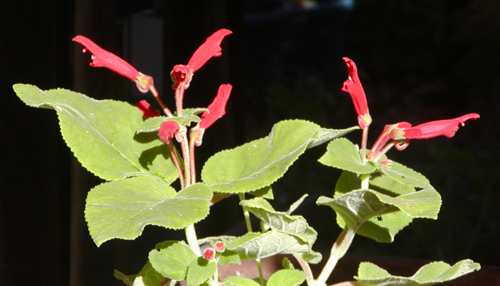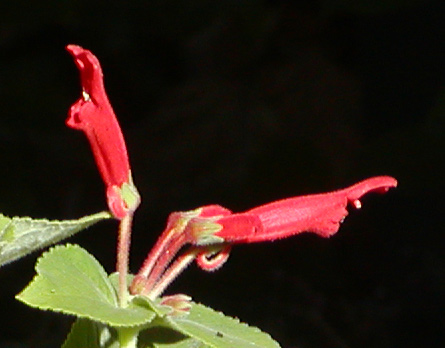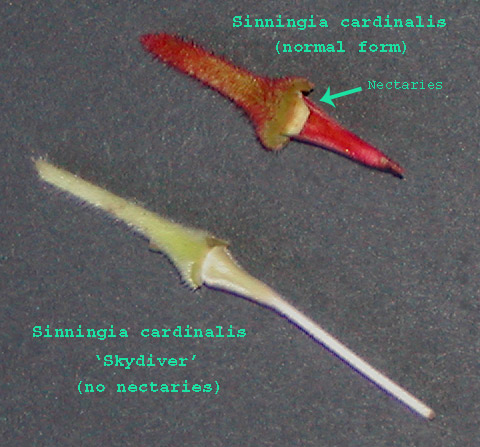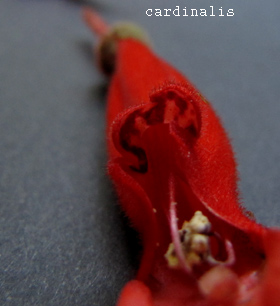
| Species list |
Hybrids list |
Tubers list |
Topics list |
Site index |
What's new |
Home page |

Sinningia cardinalis is the most familiar of the "rechsteineria" sinningias. It has been in cultivation for many decades.
It is the archetypal member of the Galea Group, its bright red flowers bearing the characteristic hood formed by the fusion of the upper two corolla lobes.
S. eumorpha and S. cardinalis were the main ingredients in the "xGloxinera" hybrids popular 50 years ago.
S. cardinalis can often get floppy before it blooms, and for that reason has lost popularity as better-behaved members of the Galea Group have been introduced, such as S. iarae and S. hatschbachii. Even so, if you want a pure-white galea flower or a peloric member of the group, S. cardinalis is still your only choice.
S. cardinalis also seems much more likely than other species to create "calyx doubles", mutants in which one or more calyx lobes have become petal-like and have the same pigmentation as the corolla.

Sinningia cardinalis 'Innocent', with pure white flowers, was introduced in 1967. The flowers are the regular cardinalis shape, with a galea, but without the red pigmentation. Since just one functioning red-pigment gene would be enough to give the flower at least some amount of reddish tinge, it is most likely that both copies of the red-pigment gene in Sinningia cardinalis 'Innocent' are defective. This is borne out by the fact that S. cardinalis 'Innocent' comes true from seed. If the white flower were dominant, at least a few of the offspring of S. cardinalis 'Innocent' should be red-flowered.
Sinningia cardinalis 'George Kalmbacher', with peloric flowers, was introduced by Carl Clayberg in 1969. Many sinningia species and hybrids produce the occasional peloric flower on an otherwise normal plant, but this was the first species other than S. speciosa to produced only peloric flowers on a single plant. Moreover the line comes true from seed.
The 1988 Sinningia Register of the AGGS (now the Gesneriad Society) describes Sinningia cardinalis 'Skydiver' as S. cardinalis 'Innocent' x S. cardinalis 'George Kalmbacher'. Since both white flowers and peloric flowers are recessive, the F1 cross should have had normal non-peloric red flowers. Therefore, it is likely that S. cardinalis 'Skydiver' was the result of more than one generation of breeding, starting with the F1 generation. S. cardinalis 'Skydiver' comes true from seed, and seed obtained from the Gesneriad Society Seed Fund in 2008 under that name yielded plants with white, peloric flowers.
Peloric flowers are often very striking, particularly when the non-peloric versions have markings on a few of the petals (corolla lobes) that are replicated to all of the lobes in the peloric version. It cannot be claimed, however, that the peloric versions of S. cardinalis are more attractive than the normal form. The peloric forms lack the galea which is the most impressive feature of the normal form.
Just as normal sinningias occasionally produce peloric flowers, Sinningia cardinalis 'Skydiver' occasionally produces non-peloric flowers. One such flower had three stamens (peloric 'Skydiver' flowers have five) and the stub of a galea.
Sinningia has a single dorsal nectary, just visibly divided into two lobes. This would be of only technical interest, except for the peloric forms. These forms, S. cardinalis 'George Kalmbacher' and S. cardinalis 'Skydiver', have five more-or-less identical corolla lobes. The question arises: which normal-form lobe is the one copied to form the rest of the lobes in the peloric form?
The nectaries can help answer that question. In the normal form, the two nectary lobes correspond to the two corolla lobes which make up the galea. If the replicated lobe was one of those, one would expect the peloric forms to have one nectary lobe for each corolla lobe.
Such is not the case. As can be seen from the picture below, S. cardinalis 'Skydiver' has no obvious nectaries at all. This is consistent with the length of the corolla. In the normal form, the anthers extend beyond the lower lobes but lie under the galea lobes. In S. cardinalis 'Skydiver', the anthers protrude beyond the corolla tube (are exserted), which suggests that the corolla lobes of the peloric forms correspond to one of the non-galea lobes of the standard form.

S. cardinalis 'Skydiver' has a kind of albino tuber. It is as if the break in the synthetic chain that ordinarily produces the red pigment of S. cardinalis flowers also affects the pigment (the same one or a related one) which colors the tuber. The tuber is white except for a greenish tinge from chlorophyll where the tuber is exposed to light.

|
Corolla MarkingSinningia cardinalis, like some other members of the Galea Group, has dark violet mark on the bottom three corolla lobes. The picture seen here shows the flower upside down, so the bottom lobes are at the top. Sinningia hatschbachii, Sinningia glazioviana, and Sinningia cooperi also have the marking, as does the hybrid Sinningia hatschbachii x glazioviana. I have not checked the other galeate species yet. |
| Plant Description |
|
| Growth | Indeterminate |
| Habit | Stem upright or sprawling (especially when young). |
| Leaves | Green |
| Dormancy | Stems deciduous, but dormancy may be facultative. Some of my plants retain stems through the winter. |
Flowering |
|
| Flowering | Spring, summer |
| Inflorescence | Axillary cyme |
| Flower | All forms have tubular flowers. The normal form is red or red-orange, with galea,
about 6 cm [2 1/4 inches] long. The S. 'Skydiver' tube, which lacks a galea, is
just under 4 cm long. See a comparison with other sinningia flowers. |
Horticultural aspects |
|
| From seed | 14 months to bloom, under my conditions |
| Hardiness | Has survived 32F (0C) in my back yard |
| Recommended? | Yes, with reservations. It's been in cultivation a long time, and it blooms easily. However, it is not easy to get a tidy, compact plant. The peloric forms need constant grooming when in bloom, because the spent flowers are held above the foliage, turn brown and unsightly, and do not drop. |
Botany |
|
| Taxonomic group | The galea group of the Dircaea clade. |
| Nectaries | One, dorsal, with two lobes. The base of the corolla has paired bulges above the nectaries, presumably to hold nectar. |
Sinningia cardinalis was first published (as a Gesneria) in 1850 by Carl Friedrich Phillip von Martius (1794-1868). H. E. Moore transferred it to Sinningia in 1973.
Etymology: Latin cardinalis ("very important, essential"), from cardo ("hinge, turning point"). Hence, the "cardinal bishops" of the Roman Catholic church, hence the color (from the red hat and robe).